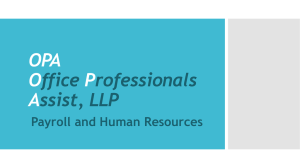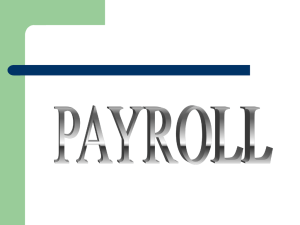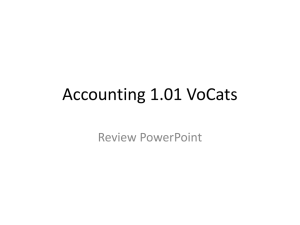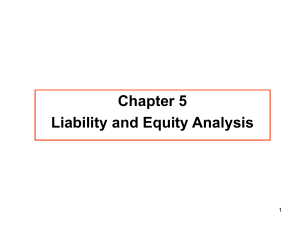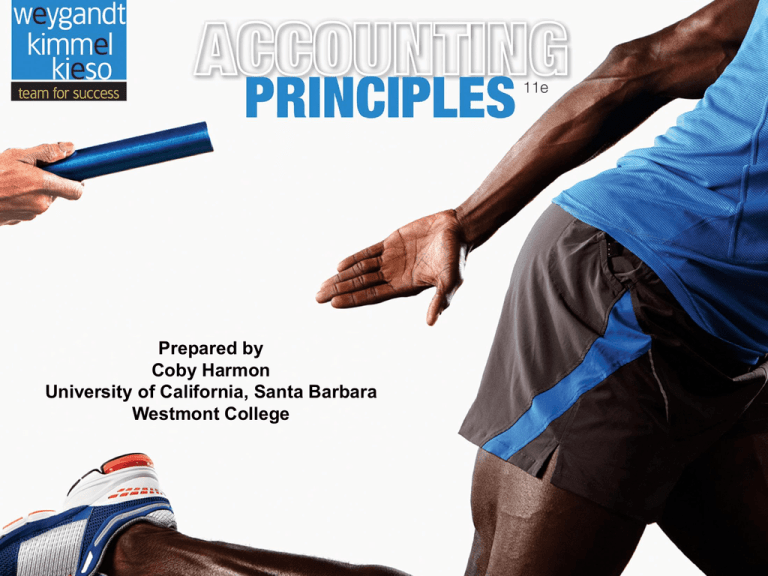
Prepared by
Coby Harmon
University of California, Santa Barbara
Westmont College
11-1
11
Current Liabilities and
Payroll Accounting
Learning Objectives
After studying this chapter, you should be able to:
[1] Explain a current liability, and identify the major types of current liabilities.
[2] Describe the accounting for notes payable.
[3] Explain the accounting for other current liabilities.
[4] Explain the financial statement presentation and analysis of current
liabilities.
[5] Describe the accounting and disclosure requirements for contingent
liabilities.
[6] Compute and record the payroll for a pay period.
[7] Describe and record employer payroll taxes.
[8] Discuss the objectives of internal control for payroll.
11-2
Preview of Chapter 11
Accounting Principles
Eleventh Edition
Weygandt Kimmel Kieso
11-3
Current Liabilities
Current liability is debt with two key features:
1. Company expects to pay the debt from existing
current assets or through the creation of other current
liabilities.
2. Company will pay the debt within one year or the
operating cycle, whichever is longer.
Current liabilities include notes payable, accounts payable, unearned
revenues, and accrued liabilities such as taxes payable, salaries and
wages payable, and interest payable.
11-4
LO 1 Explain a current liability, and identify the
major types of current liabilities.
Accounting for Current Liabilities
Question
To be classified as a current liability, a debt must be
expected to be paid:
a. out of existing current assets.
b. by creating other current liabilities.
c. within 2 years.
d. both (a) and (b).
11-5
LO 1 Explain a current liability, and identify the
major types of current liabilities.
Accounting for Current Liabilities
Notes Payable
11-6
Written promissory note.
Requires the borrower to pay interest.
Issued for varying periods.
LO 2 Describe the accounting for notes payable.
Accounting for Current Liabilities
Illustration: First National Bank agrees to lend $100,000 on
September 1, 2014, if Cole Williams Co. signs a $100,000,
12%, four-month note maturing on January 1.
Instructions
a) Prepare the entry on September 1st.
b) Prepare the adjusting entry on Dec. 31st, assuming
monthly adjusting entries have not been made.
c) Prepare the entry at maturity (Jan. 1, 2015).
11-7
LO 2 Describe the accounting for notes payable.
Accounting for Current Liabilities
Illustration: First National Bank agrees to lend $100,000 on
September 1, 2014, if Cole Williams Co. signs a $100,000,
12%, four-month note maturing on January 1.
a) Prepare the entry on Sept. 1st.
Cash
100,000
Notes Payable
100,000
b) Prepare the adjusting entry on Dec. 31st.
Interest Expense
4,000
Interest Payable
4,000
$100,000 x 12% x 4/12 = $4,000
11-8
LO 2 Describe the accounting for notes payable.
Accounting for Current Liabilities
Illustration: First National Bank agrees to lend $100,000 on
September 1, 2014, if Cole Williams Co. signs a $100,000,
12%, four-month note maturing on January 1.
c) Prepare the entry at maturity.
Notes Payable
Interest Payable
Cash
11-9
100,000
4,000
104,000
LO 2 Describe the accounting for notes payable.
Accounting for Current Liabilities
Sales Taxes Payable
Sales taxes are expressed as a stated percentage of
the sales price.
Either rung up separately or included in total receipts.
Retailer collects tax from the customer.
Retailer remits the collections to the state’s department
of revenue.
11-10
LO 3 Explain the accounting for other current liabilities.
Accounting for Current Liabilities
Illustration: The March 25 cash register reading for Cooley
Grocery shows sales of $10,000 and sales taxes of $600 (sales
tax rate of 6%), the journal entry is:
Cash
10,600
Sales Revenue
Sales Taxes Payable
11-11
10,000
600
LO 3 Explain the accounting for other current liabilities.
Accounting for Current Liabilities
Unearned Revenue
Revenues received before the company
delivers goods or
provides services.
Illustration 11-2
11-12
LO 3 Explain the accounting for other current liabilities.
Accounting for Current Liabilities
Illustration: Superior University sells 10,000 season football
tickets at $50 each for its five-game home schedule. The
university makes the following entry for the sale of season
tickets:
Aug. 6
Cash
Unearned Ticket Revenue
500,000
500,000
As the school completes each of the five home games, it would
record the revenue earned.
Sept. 7
11-13
Unearned Ticket Revenue
Ticket Revenue
100,000
100,000
LO 3 Explain the accounting for other current liabilities.
Accounting for Current Liabilities
Current Maturities of Long-Term Debt
Portion of long-term debt that comes due in the current
year.
11-14
No adjusting entry required.
LO 3 Explain the accounting for other current liabilities.
Accounting for Current Liabilities
Statement
Presentation
Illustration 11-3
11-15
Accounting for Current Liabilities
Question
Working capital is calculated as:
a. current assets minus current liabilities.
b. total assets minus total liabilities.
c. long-term liabilities minus current liabilities.
d. both (b) and (c).
11-16
LO 4 Explain the financial statement presentation
and analysis of current liabilities.
Accounting for Current Liabilities
Analysis
Illustration 11-4
Current ratio permits us to
compare the liquidity of
different-sized companies
and of a single company at
different times.
11-17
Liquidity refers to the
ability to pay maturing
obligations and meet
unexpected needs for
cash.
Illustration 11-5
LO 4 Explain the financial statement presentation
and analysis of current liabilities.
Contingent Liabilities
Potential liability that may become an actual liability in the
future.
Three levels of probability:
11-18
Probable.
Reasonably possible.
Remote.
LO 5 Describe the accounting and disclosure
requirements for contingent liabilities.
Contingent Liabilities
11-19
Probability
Accounting
Probable
Accrue
Reasonably
Possible
Footnote
Remote
Ignore
LO 5 Describe the accounting and disclosure
requirements for contingent liabilities.
Contingent Liabilities
Question
A contingent liability should be recorded in the accounts when:
a. it is probable the contingency will happen, but the
amount cannot be reasonably estimated.
b. it is reasonably possible the contingency will happen,
and the amount can be reasonably estimated.
c. it is probable the contingency will happen, and the
amount can be reasonably estimated.
d. it is reasonably possible the contingency will happen,
but the amount cannot be reasonably estimated.
11-20
LO 5 Describe the accounting and disclosure
requirements for contingent liabilities.
11-21
Contingent Liabilities
Recording a Contingent Liability
Product Warranties
Promise made by a seller to a buyer to make good on a
deficiency of quantity, quality, or performance in a product.
Estimated cost of honoring product warranty contracts should
be recognized as an expense in the period in which the sale
occurs.
11-22
LO 5 Describe the accounting and disclosure
requirements for contingent liabilities.
Contingent Liabilities
Illustration: Denson Manufacturing Company sells 10,000
washers and dryers at an average price of $600 each. The
selling price includes a one-year warranty on parts. Denson
expects that 500 units (5%) will be defective and that warranty
repair costs will average $80 per unit. In 2014, the company
honors warranty contracts on 300 units, at a total cost of
$24,000. At December 31, compute the estimated warranty
liability.
Illustration 11-6
Computation of estimated
product warranty liability
11-23
LO 5
Contingent Liabilities
Illustration: Denson Manufacturing Company sells 10,000
washers and dryers at an average price of $600 each. The
selling price includes a one-year warranty on parts. Denson
expects that 500 units (5%) will be defective and that warranty
repair costs will average $80 per unit. In 2014, the company
honors warranty contracts on 300 units, at a total cost of
$24,000. At December 31, compute the estimated warranty
liability. Make the required adjusting entry.
Warranty Expense
Warranty Liability
11-24
40,000
40,000
LO 5 Describe the accounting and disclosure
requirements for contingent liabilities.
Contingent Liabilities
Illustration: Prepare the entry to record the repair costs
incurred in 2014 to honor warranty contracts on 2014 sales.
Warranty Liability
24,000
Repair Parts
24,000
Assume that the company replaces 20 defective units in
January 2015, at an average cost of $80 in parts and labor.
Warranty Liability
Repair Parts
11-25
1,600
1,600
LO 5 Describe the accounting and disclosure
requirements for contingent liabilities.
Contingent Liabilities
Disclosure of Contingent Liabilities
Illustration 11-7
11-26
LO 5 Describe the accounting and disclosure
requirements for contingent liabilities.
Payroll Accounting
“Payroll” pertains to both:
Salaries - managerial, administrative, and sales personnel
(monthly or yearly rate).
Wages - store clerks, factory employees, and manual
laborers (rate per hour).
Determining the Payroll
Involves computing three amounts: (1) gross earnings, (2)
payroll deductions, and (3) net pay.
11-27
LO 6 Compute and record the payroll for a pay period.
Determining the Payroll
Gross Earnings
Total compensation earned by an employee (wages or
salaries, plus any bonuses and commissions).
Illustration 11-8
11-28
LO 6 Compute and record the payroll for a pay period.
Determining the Payroll
Payroll Deductions
Mandatory:
11-29
Voluntary:
FICA taxes
Charity
Federal income taxes
Insurance
State income taxes
Union dues
Pension plans
LO 6 Compute and record the payroll for a pay period.
Determining the Payroll
Payroll Deductions
Social Security taxes
Supplemental retirement,
employment disability, and
medical benefits.
The FICA rate is 7.65%:
Mandatory:
11-30
FICA taxes
Federal income taxes
State income taxes
Social Security (6.2% on
salary and wages up to
$110,100).
Medicare (1.45% on all
salary and wages without
limitation).
LO 6 Compute and record the payroll for a pay period.
Determining the Payroll
Payroll Deductions
Mandatory:
FICA taxes
Federal income taxes
11-31
State income taxes
Employers are required to
withhold income taxes from
employees’ pay.
Withholding amounts are based
on gross wages and the number
of allowances claimed.
LO 6 Compute and record the payroll for a pay period.
Determining the Payroll
Payroll Deductions
Mandatory:
11-32
FICA taxes
Federal income taxes
State income taxes
Most states (and some cities)
require employers to withhold
income taxes from
employees’ earnings.
LO 6 Compute and record the payroll for a pay period.
Determining the Payroll
Net Pay
Gross earnings minus payroll deductions.
Illustration 11-13
11-33
LO 6 Compute and record the payroll for a pay period.
Recording the Payroll
Maintaining Payroll Department Records
An employer must keep a cumulative record of each employee’s gross
earnings, deductions, and net pay during the year.
Illustration 11-14
11-34
LO 6
Recording the Payroll
Maintaining Payroll Department Records
Many companies find it useful to prepare a payroll register.
Illustration11-13
11-15
Illustration
11-35
LO 6
Recording the Payroll
Recognizing Payroll Expenses and Liabilities
Illustration: Prepare the entry Academy Company would make to
record the payroll for the week ending January 14.
Salaries and Wages Expense
FICA Taxes Payable
1,316.67
Federal Income taxes Payable
3,490.00
State Income Taxes Payable
344.20
United Way Payable
421.50
Union Dues Payable
115.00
Salaries and Wages Payable
11-36
17,210.00
11,522.73
LO 6 Compute and record the payroll for a pay period.
Recording the Payroll
Recording Payment of the Payroll
Illustration: Prepare the entry Academy Company would make to
record the payment of the payroll.
Salaries and Wages Payable
Cash
11-37
11,522.73
11,522.73
LO 6 Compute and record the payroll for a pay period.
Recording the Payroll
Illustration 11-16
Paycheck and
statement of
earnings
11-38
LO 6 Compute and record the payroll for a pay period.
Employer Payroll Taxes
Payroll tax expense results from three taxes that
governmental agencies levy on employers.
These taxes are:
FICA taxes
Federal
unemployment taxes
11-39
State unemployment
taxes
Social Security taxes
Supplemental retirement,
employment disability, and
medical benefits.
The FICA rate is 7.65%:
Social Security (6.2% on
salary and wages up to
$110,100).
Medicare (1.45% on all
salary and wages without
limitation).
LO 7
Employer Payroll Taxes
Payroll tax expense results from three taxes that
governmental agencies levy on employers.
These taxes are:
11-40
FICA taxes
Federal
unemployment taxes
State unemployment
taxes
FUTA tax rate is 6.2% of first
$7,000 of taxable wages.
Employers who pay the state
unemployment tax on a timely
basis will receive an offset credit
of up to 5.4%. Therefore, the net
federal tax rate is generally
0.8%.
LO 7 Describe and record employer payroll taxes.
Employer Payroll Taxes
Payroll tax expense results from three taxes that
governmental agencies levy on employers.
These taxes are:
11-41
FICA taxes
Federal
unemployment taxes
State unemployment
taxes
Helpful Hint Both the employer
and employee pay FICA taxes.
Federal unemployment taxes
and (in most states) the state
unemployment taxes are
borne entirely by the employer.
SUTA basic rate is usually 5.4%
on the first $7,000 of wages paid.
LO 7 Describe and record employer payroll taxes.
Employer Payroll Taxes
Illustration: Academy records the payroll tax expense
associated with the January 14 payroll with the following entry.
Use the following rates: FICA 7.65%, state unemployment
5.4%, federal unemployment 0.8%.
Payroll Tax Expense
2,383.59
FICA Taxes Payable
1,316.57 *
State Unemployment Taxes Payable
Federal Unemployment Taxes Payable
137.68
11-42
*
$ 17,210.00 x 7.65% = $1,316.57
**
$17,210.00 x 5.4% = $929.34
***
929.34 **
***
$17,210 x .8% = $137.68
LO 7 Describe and record employer payroll taxes.
Employer Payroll Taxes
Question
Employer payroll taxes do not include:
a. Federal unemployment taxes.
b. State unemployment taxes.
c. Federal income taxes.
d. FICA taxes..
11-43
LO 7 Describe and record employer payroll taxes.
11-44
Filing and Remitting Payroll Taxes
Companies must report FICA taxes and federal income taxes
withheld no later than one month following the close of each
quarter.
Companies generally file and remit federal unemployment
taxes annually on or before January 31 of the subsequent
year. Companies usually file and pay state unemployment
taxes by the end of the month following each quarter.
Employers must provide each employee with a Wage and Tax
Statement (Form W-2) by January 31.
11-45
LO 7 Describe and record employer payroll taxes.
ANATOMY OF A FRAUD
Art was a custodial supervisor for a large school district. The district was supposed
to employ between 35 and 40 regular custodians, as well as 3 or 4 substitute
custodians to fill in when regular custodians were missing. Instead, in addition to the
regular custodians, Art “hired” 77 substitutes. In fact, almost none of these people
worked for the district. Instead, Art submitted time cards for these people, collected
their checks at the district office, and personally distributed the checks to the
“employees.” If a substitute’s check was for $1,200, that person would cash the
check, keep $200, and pay Art $1,000.
Total take: $150,000
The Missing Control
Human Resource Controls. Thorough background checks should be performed.
No employees should begin work until they have been approved by the Board of
Education and entered into the payroll system. No employees should be entered
into the payroll system until they have been approved by a supervisor. All
paychecks should be distributed directly to employees at the official school
locations by designated employees.
Independent internal verification. Budgets should be reviewed monthly to identify
situations where actual costs significantly exceed budgeted amounts.
Source: Adapted from Wells, Fraud Casebook (2007), pp. 164–171.
11-46
Internal Control for Payroll
11-47
LO 8 Discuss the objectives of internal control for payroll.
APPENDIX 11A
Additional Fringe APPENDIX
Benefits
Additional Fringe Benefits
In addition to the three payroll-tax fringe benefits, employers
incur other substantial fringe benefit costs.
Two important fringe benefits include:
11-48
Paid absences
Post-retirement benefits
LO 9 Identify additional fringe benefits associated
with employee compensation.
APPENDIX 11A
Additional Fringe Benefits
Paid Absences
11-49
Employees often are given rights to receive compensation for
absence when they meet certain conditions of employment.
The compensation may be for paid vacations, sick pay
benefits, and paid holidays.
When the payment for such absences is probable and the
amount can be reasonably estimated, the company should
accrue a liability for paid future absences.
When the amount cannot be reasonably estimated, the
company should instead disclose the potential liability.
LO 9 Identify additional fringe benefits associated
with employee compensation.
APPENDIX 11A
Additional Fringe APPENDIX
Benefits
Postretirement Benefits
Post-retirement benefits are benefits that employers provide
to retired employees for
1. pensions and
2. health care and life insurance.
Companies account for post-retirement benefits on the
accrual basis.
11-50
LO 9 Identify additional fringe benefits associated
with employee compensation.
APPENDIX 11A
Additional Fringe Benefits
Pensions
A pension plan is an agreement whereby employers provide
benefits to employees after they retire.
Two types of pension plans:
11-51
1.
In a defined-contribution plan, the plan defines the contribution
that an employer will make but not the benefit that the employee
will receive at retirement. This is often referred to as a 401 (k)
plan.
2.
In a defined-benefit plan, the employer agrees to pay a defined
amount to retirees, based on employees meeting certain eligibility
standards.
LO 9 Identify additional fringe benefits associated
with employee compensation.
A Look at IFRS
Key Points
11-52
The basic definition of a liability under GAAP and IFRS is very similar. In
a more technical way, liabilities are defined by the IASB as a present
obligation of the entity arising from past events, the settlement of which
is expected to result in an out flow from the entity of resources
embodying economic benefits. Liabilities may be legally enforceable via
a contract or law but need not be; that is, they can arise due to normal
business practice or customs.
LO 10 Compare the accounting procedures for
payroll under GAAP and IFRS.
A Look at IFRS
Key Points
11-53
IFRS requires that companies classify liabilities as current or noncurrent
on the face of the statement of financial position (balance sheet), except
in industries where a presentation based on liquidity would be
considered to provide more useful information (such as financial
institutions). When current liabilities (also called short-term liabilities) are
presented, they are generally presented in order of liquidity.
Under IFRS, liabilities are classified as current if they are expected to be
paid within 12 months.
Similar to GAAP, items are normally reported in order of liquidity.
Companies sometimes show liabilities before assets. Also, they will
sometimes show long-term liabilities before current liabilities.
LO 10 Compare the accounting procedures for
payroll under GAAP and IFRS.
A Look at IFRS
Key Points
11-54
Under IFRS, companies sometimes will net current liabilities against
current liabilities to show working capital on the face of the statement of
financial position. (This is evident in the Zetar financial statements in
Appendix F.)
Under GAAP, some contingent liabilities are recorded in the financial
statements, others are disclosed, and in some cases no disclosure is
required. Unlike GAAP, IFRS reserves the use of the term contingent
liability to refer only to possible obligations that are not recognized in the
financial statements but may be disclosed if certain criteria are met.
LO 10 Compare the accounting procedures for
payroll under GAAP and IFRS.
A Look at IFRS
Key Points
11-55
For those items that GAAP would treat as recordable contingent
liabilities, IFRS instead uses the term provisions. Provisions are defined
as liabilities of uncertain timing or amount. Examples of provisions would
be provisions for warranties, employee vacation pay, or anticipated
losses. Under IFRS, the measurement of a provision related to a
uncertain obligation is based on the best estimate of the expenditure
required to settle the obligation.
IFRS and GAAP separate plans into defined benefit and defined
contribution. The IASB and FASB are working on a joint project on
pensions that will dramatically change the approach used by both.
LO 10 Compare the accounting procedures for
payroll under GAAP and IFRS.
A Look at IFRS
Looking to the Future
The FASB and IASB are currently involved in two projects, each of which
has implications for the accounting for liabilities. One project is investigating
approaches to differentiate between debt and equity instruments. The other
project, the elements phase of the conceptual framework project, will
evaluate the definitions of the fundamental building blocks of accounting.
The results of these projects could change the classification of many debt
and equity securities.
11-56
LO 10 Compare the accounting procedures for
payroll under GAAP and IFRS.
A Look at IFRS
IFRS Self-Test Questions
Which of the following is false?
a) Under IFRS, current liabilities must always be presented
before non-current liabilities.
b) Under IFRS, an item is a current liability if it will be paid within
the next 12 months.
c) Under IFRS, current liabilities are shown in order of liquidity.
d) Under IFRS, a liability is only recognized if it is a present
obligation.
11-57
LO 10 Compare the accounting procedures for
payroll under GAAP and IFRS.
A Look at IFRS
IFRS Self-Test Questions
Under IFRS, a contingent liability is:
a) disclosed in the notes if certain criteria are met.
b) reported on the face of the financial statements if certain
criteria are met.
c) the same as a provision.
d) not covered by IFRS.
11-58
LO 10 Compare the accounting procedures for
payroll under GAAP and IFRS.
A Look at IFRS
IFRS Self-Test Questions
Under IFRS, obligations related to warranties are considered:
a) contingent liabilities.
b) provisions.
c) possible obligations.
d) None of these.
11-59
LO 10 Compare the accounting procedures for
payroll under GAAP and IFRS.
Copyright
“Copyright © 2013 John Wiley & Sons, Inc. All rights reserved.
Reproduction or translation of this work beyond that permitted in
Section 117 of the 1976 United States Copyright Act without the
express written permission of the copyright owner is unlawful.
Request for further information should be addressed to the
Permissions Department, John Wiley & Sons, Inc. The purchaser
may make back-up copies for his/her own use only and not for
distribution or resale. The Publisher assumes no responsibility for
errors, omissions, or damages, caused by the use of these
programs or from the use of the information contained herein.”
11-60

![[Product Name]](http://s2.studylib.net/store/data/005238235_1-ad193c18a3c3c1520cb3a408c054adb7-300x300.png)

